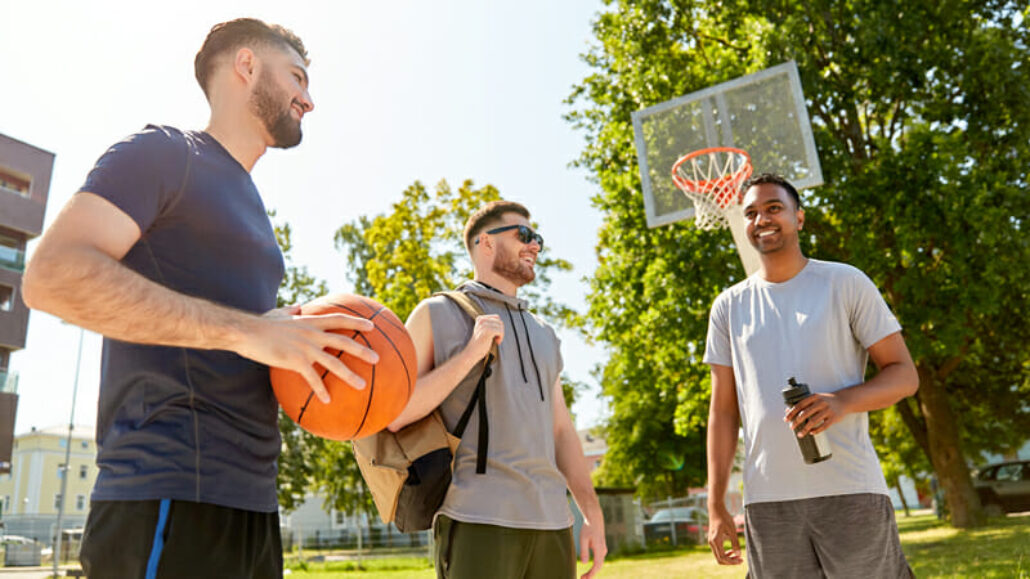Learn why muscle fatigue may be the culprit behind recreational basketball injuries.
Every sport has associated injuries, including basketball. But injuries that plague professional players aren’t necessarily the same as the recreational basketball injuries treated by our sports medicine doctors. We asked sports medicine specialist Dr. Angela Voight about the most common recreational basketball injuries she sees in her practice.
Why do recreational basketball injuries happen?
“A lot of the patients I treat for recreational basketball injuries are people who play infrequently,” says Dr. Voight. “If you are playing basketball on weekends now and then, you may not have the same conditioning or cardiovascular fitness that a professional player has. In addition, you may not be used to playing a lot. And the intensity of intermittent games may be challenging for you. This combination of factors leads to muscle fatigue. And muscle fatigue means higher risk of injury.”
How muscle fatigue increases recreational basketball injury risks
“Our muscles have a number of functions,” explains Dr. Voight. “Muscles do power you through a game—but that’s not all they do. Your muscles are also protecting your body as you play. Muscles help absorb impact. When you make strenuous demands on your muscles for an extended period of time—as you do in a game—those muscles are going to get tired. This lowers their ability to protect your bones during impact as you run or jump and land. When bones are more exposed to impact forces, you are more likely to suffer bone injuries.
Dr. Voight notes that muscle fatigue also affects coordination. “When your muscles tire, you are also more likely to injure ligaments or joints,” she says. “I just treated someone who had played for an hour straight and developed a knee injury because of muscle fatigue. When you exert yourself and develop fatigue, you are more prone to recreational basketball injuries.”
Additionally, intense exercise without conditioning can also result in muscle cramps or muscle strains. “Early in the season, I see a lot of cramping and strains in young athletes,” says Dr. Voight. “These symptoms can affect recreational players too. When you haven’t been practicing or playing as much, your muscles can’t keep up and cramp.”
Common recreational basketball injuries
“The recreational basketball injuries I see regularly are ankle sprains, knee injuries, and Achilles tendon strains or chronic Achilles tendinitis,” notes Dr. Voight. “Basketball-related knee injuries can include patellar tendinitis, sprains, strains, MCL or ACL injuries, meniscus injuries, and general knee pain. Patellofemoral knee pain is especially common for weekend athletes. Recreational athletes are also at risk for hand and wrist injuries—but those conditions are treated by my Summit colleagues who specialize in upper extremity injuries.”
Injuries specifically affecting younger basketball players
“We are talking about recreational basketball injuries, but there’s one injury type that parents with young basketball players should know too,” states Dr. Voight. “I see a lot of growth plate injuries in younger recreational athletes. It’s true that most children with these injuries are athletes participating in organized school teams. But growth plate injuries need attention whether a child is a recreational player or a team athlete.”
Symptoms that need medical evaluation
“If you think you’ve been injured, there are a number of symptoms to watch for,” says Dr. Voight. “If you experience any of them, it’s a good idea to have them medically evaluated by a sports medicine doctor. When you ignore symptoms, you risk worse damage to the tissues or joint.”
- Difficulty with walking and weight-bearing. “Is it hard to walk right after the injury, or on the day following the injury?” asks Dr. Voight. “Do you have a hard time with weight-bearing? Is there a lot of pain with normal walking? All of these symptoms should be evaluated.”
- If you experience a lot of swelling, or swelling that doesn’t resolve with ice and elevation, you have cause for concern.
- Noticeable trauma to the joint. “Sometimes, a more traumatic joint injury announces itself,” says Dr. Voight. “You might feel a pop or a pull in the joint. Or the joint might feel as though it is giving out. These feelings might be followed by pain and joint swelling. If this happens, you should be evaluated.
- Significant pain. Any time you experience significant pain that does not get better within 24 hours, you should call for a medical evaluation.
“Whether or not you enjoy the occasional basketball game, it’s always a good idea to maintain a fitness program focused on strength, coordination, and balance,” advises Dr. Voight. “And if you do experience recreational basketball injuries, come and see me. Let’s make sure we address injuries promptly, before they become more serious. I want to get you back on the court safely, so you can continue to enjoy the sports you love.”
Summit Orthopedics offers comprehensive sports medicine expertise
From Olympians to pro athletes to kids in youth sports and those who just want to be more active—Summit Orthopedics delivers expert care by fellowship-trained sports medicine physicians. If you are recently injured or concerned about ongoing pain, Summit Orthopedics sports medicine specialists have the expertise to evaluate your discomfort and develop a plan to quickly and safely help you get back to being active.
Start your journey to stronger, healthier athletic condition. Find your sports medicine expert, request an appointment online, or call us at (651) 968-5201 to schedule a sports medicine consultation.
Summit has convenient locations across the Minneapolis-St. Paul metro area, serving Minnesota and western Wisconsin. We have state-of-the-art centers for comprehensive orthopedic care in Eagan, MN, Plymouth, MN, Vadnais Heights, MN, and Woodbury, MN, as well as additional community clinics throughout the metro and southern Minnesota.
More resources for you
- Learn more about high school basketball injury prevention

